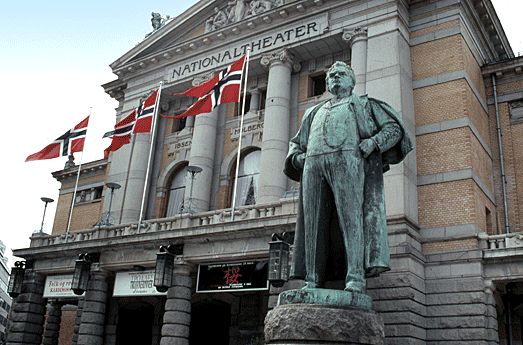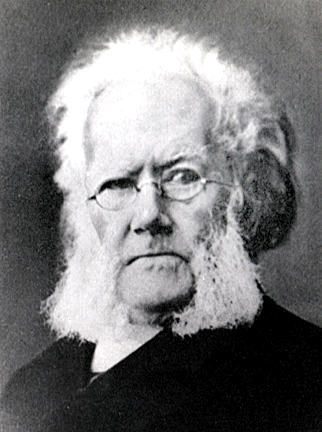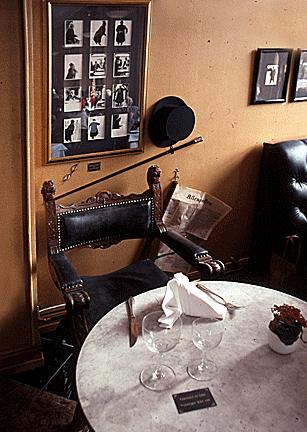Henrik Ibsen—Norway's Master Playwright
by Bob Brooke
Playwright Henrik Ibsen stands watch over Oslo from his pedestal in
front of Norway’s National Theater. Cast in bronze, he can no longer
speak, but his words echo for all eternity from his plays.

Born on March 20, 1828, in Norway, Ibsen grew up in the small
coastal town of Skien as the eldest of five children of Knud and
Marichen Ibsen. His father was a successful merchant and his mother
painted, played the piano and loved to go to the theater. Even at an
early age, Ibsen expressed an interest in becoming an artist.
But while he was very young, his father had problems with his
business and the family became poor. They had to sell off nearly
everything just to cover debts and eventually moved to a rundown
farm at the edge of town. There Ibsen spent much of his time
reading, painting and performing magic tricks.
At 15, he quit school and went to work as an apprentice in an
apothecary in Grimstad where he worked for six years. He spent his
limited free time painting and writing poetry. In 1849, he wrote his
first play Catilina, a drama written in verse modeled after those of
William Shakespeare.
Early Works
Ibsen moved to Christiania—later renamed Oslo—in 1850 to prepare for
entrance examinations to the University of Christiania. While living
in the capital, he made friends with other writers and artistic
types. One of these friends, Oleg Schulerud, paid for the
publication of Catilina, which failed to get much notice.
The following year, Ibsen met violinist and theater manager Oleg
Bull. Bull liked Ibsen and offered him a job as a writer and manager
for the Norwegian Theater in Bergen. The position proved to be an
intense tutorial in all things theatrical and even included
traveling abroad to learn more about theater craft. In 1857, Ibsen
returned to Christiania to run another theater there. But he ran
into problems and people accused him of mismanagement and called for
his replacement. Despite his difficulties, Ibsen found time to write
Love's Comedy, a satirical look at marriage, in 1862.
Writing in Exile
 That same year, and because of the problems at the Norwegian
Theater, Ibsen left Norway, and eventually settled in Italy. There,
in 1865, he wrote Brand, a five-act tragedy about a clergyman whose
feverish devotion to his faith costs him his family and ultimately
his life. The play made him famous. Two years later, he created one
of his masterworks, Peer Gynt. A modern take on the Greek epics, in
which play follows the lead character on a quest. That same year, and because of the problems at the Norwegian
Theater, Ibsen left Norway, and eventually settled in Italy. There,
in 1865, he wrote Brand, a five-act tragedy about a clergyman whose
feverish devotion to his faith costs him his family and ultimately
his life. The play made him famous. Two years later, he created one
of his masterworks, Peer Gynt. A modern take on the Greek epics, in
which play follows the lead character on a quest.
In 1868, Ibsen moved to Germany. During his time there, he witnessed
his social drama The Pillars of Society first performed in Munich.
The play helped launch his career and was soon followed up by one of
his most famous works, A Doll's House. This 1879 play aroused
controbersy throughout Europe for its exploration of the lead
character’s struggle with the traditional roles of wife and mother
and her own need for self-exploration. Once again, Ibsen questioned
the accepted social practices of the time, surprising his audiences
and stirring up debate. Around this time, he returned to Rome.
His next work, Ghosts, written in 1881, stirred up even more
controversy by tackling such topics as incest and venereal disease.
The outcry was so strong that the play wasn't performed widely until
two years later. His next work, An Enemy of the People, showed one
man in conflict with his community. Some critics say it was Ibsen's
response to the backlash he received for Ghosts. Ibsen wrote The
Lady From the Sea in 1888 and then headed back to Norway, where he
spent the remainder of his years. He wrote Hedda Gabler, one of his
most famous plays, in 1890. It featured one of the modern theater's
most notorious characters. Hedda, a general's daughter and a
newlywed who has come to loathe her scholarly husband, but yet she
destroys a former love who stands in her husband's way academically.
Return to Norway
 In 1891, Ibsen returned to Norway as a literary hero. Though Ibsen
may have left Norway as a frustrated artist, he returned an
internationally acclaimed playwright. Though he lived the life of a
recluse for much of his life, Ibsen thrived in the celebrity
spotlight of his later years. In 1891, Ibsen returned to Norway as a literary hero. Though Ibsen
may have left Norway as a frustrated artist, he returned an
internationally acclaimed playwright. Though he lived the life of a
recluse for much of his life, Ibsen thrived in the celebrity
spotlight of his later years.
Each day, Ibsen would go to the café in the Grand
Hotel for lunch. He sat at the same table which the café preserves
to this day as a memorial to the playwright.
His later works seem to have a more self-reflective quality with
mature lead characters looking back and living with the consequences
of their earlier life choices. And each drama seems to end on a dark
note. The first play written after his return to Norway was The
Master Builder. The title character encounters a woman from his past
who encourages him to make good on a promise. In When We Dead
Awaken, written in 1899, an old sculptor runs into one of his former
models and tries to recapture his lost creative spark. It proved to
be his final play.
Final Years
In 1900, Ibsen had a series of strokes that left him unable to
write. Though he lived for several more years, he wasn’t fully
cognizant during much of this time. Ibsen died on May 23, 1906. His
last words were "To the contrary!" in Norwegian, of course. The
Norwegian Government considered him a literary titan at the time of
his passing and gave him a state funeral.
His Most Famous Works Live On
Three of his plays—Peer Gynt, A Doll's House, and Hedda Gabler— are
the most widely produced plays today. He like Gustav Vigeland,
another of Norway’s great artists, lives on through his works.
< Back to Norway Articles
Go to Out and About in Oslo >
|